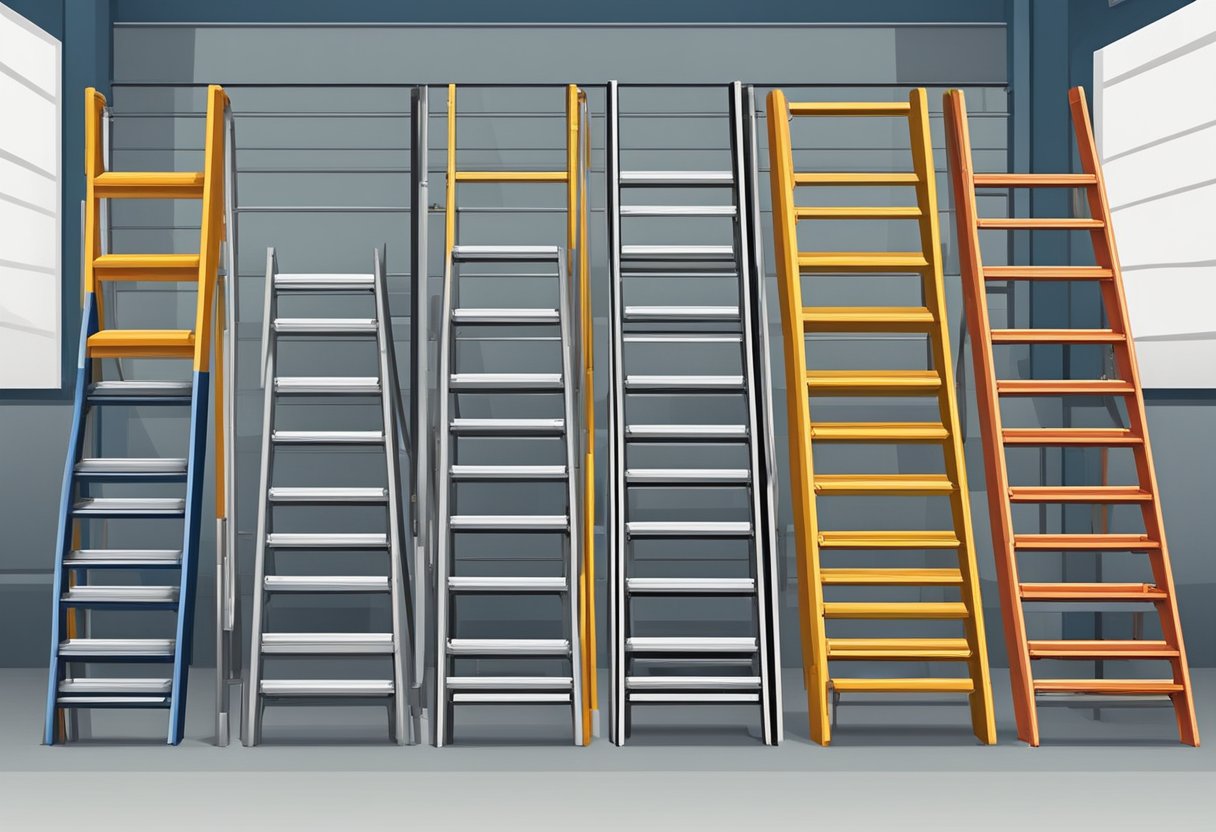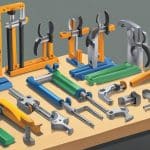Types Of Ladders
Ladders are an essential tool for any DIY project or professional job that involves reaching heights. With so many different types of ladders available, it can be challenging to determine which one is best suited for your needs. In this article, we will explore the different types of ladders, ladder materials, safety and maintenance, selecting the right ladder, and practical applications.
There are many types of ladders available, each designed for specific purposes. Some of the most common types of ladders include step ladders, extension ladders, multi-purpose ladders, attic ladders, and fire escape ladders. The type of ladder you choose will depend on the job you need to complete, the height you need to reach, and the amount of weight the ladder needs to support.
When it comes to ladder materials, there are several options to choose from, including aluminum, fiberglass, and wood. Each material has its advantages and disadvantages, so it’s essential to consider factors such as weight, durability, and cost before making a final decision. Additionally, safety and maintenance are crucial factors to consider when using a ladder. Proper ladder safety techniques and regular maintenance can help prevent accidents and prolong the life of your ladder.
Key Takeaways
- There are several types of ladders available, each designed for specific purposes.
- Ladders can be made from a variety of materials, including aluminum, fiberglass, and wood, each with its advantages and disadvantages.
- Safety and maintenance are crucial when using a ladder to prevent accidents and prolong the life of your ladder.
Types of Ladders

When it comes to choosing the right ladder for the job, it’s important to understand the types of ladders available. Each type of ladder has its own unique features and benefits, which makes them suitable for different tasks. Here are some of the most common types of ladders:
Step Ladders
Step ladders are the most common type of ladder and are often used for tasks that require a stable and secure platform. They are typically self-supporting and can be used in a variety of settings. Step ladders come in different sizes, with the most common being 6, 8, and 10 feet. They are made of different materials, including aluminum, fiberglass, and wood.
Extension Ladders
Extension ladders are used for tasks that require reaching high places, such as cleaning gutters or painting the exterior of a house. They consist of two or more sections that can be extended to reach different heights. Extension ladders come in different sizes, with the most common being 16, 20, and 24 feet. They are made of different materials, including aluminum, fiberglass, and wood.
Multi-Purpose Ladders
Multi-purpose ladders are versatile and can be used in a variety of settings. They can be used as step ladders, extension ladders, or as scaffolding. Multi-purpose ladders come in different sizes and are made of different materials, including aluminum and fiberglass.
Platform Ladders
Platform ladders are similar to step ladders, but they have a larger platform at the top, which provides a stable and secure platform for the user. They are often used in industrial settings, such as warehouses or factories. Platform ladders come in different sizes and are made of different materials, including aluminum and fiberglass.
Specialized Ladders
There are also specialized ladders that are designed for specific tasks. For example, attic ladders are used for accessing attics, while fire escape ladders are used for emergency situations. These ladders come in different sizes and are made of different materials, depending on their intended use.
In conclusion, choosing the right ladder for the job is essential to ensure safety and efficiency. By understanding the different types of ladders available, users can choose the one that meets their needs and requirements.
Ladder Materials
When it comes to choosing the right ladder, one of the most important factors to consider is the material it is made of. The three most common materials used for ladders are wood, aluminum, and fiberglass. Each material has its own set of advantages and disadvantages, and choosing the right one will depend on your specific needs.
Wooden Ladders
Wooden ladders have been around for centuries and are still popular today. They are known for their durability and strength, making them a great choice for heavy-duty work. They are also resistant to corrosion, making them a good choice for outdoor use. However, wooden ladders can be heavy and difficult to maneuver, and they are not as long-lasting as some other materials.
Aluminum Ladders
Aluminum ladders are lightweight and easy to move around, making them a popular choice for many people. They are also corrosion-resistant, making them a good option for outdoor use. Aluminum ladders are a great choice for those who need a ladder for light-duty work, but they may not be the best choice for heavy-duty work as they are not as strong as some other materials.
Fiberglass Ladders
Fiberglass ladders are known for their strength and durability, making them a great choice for heavy-duty work. They are also corrosion-resistant, making them a good option for outdoor use. Fiberglass ladders are a great choice for those who need a ladder that will last a long time, but they can be heavy and difficult to maneuver.
In summary, when choosing a ladder, it is important to consider the material it is made of. Wooden ladders are durable and corrosion-resistant but can be heavy. Aluminum ladders are lightweight and corrosion-resistant but not as strong as some other materials. Fiberglass ladders are strong and durable but can be heavy. Choose the material that best suits your needs.
Safety and Maintenance
Ladders are an essential tool for many jobs, but they can also be dangerous if not used properly. Proper use and maintenance of ladders are necessary to ensure safety. In this section, we will discuss some safety tips and maintenance procedures to keep in mind when using ladders.
Proper Use and Handling
One of the most important safety tips when using ladders is to use them properly. Always follow the ladder’s instructions and safety guidelines. Never use a ladder for anything other than its intended purpose. Always maintain three points of contact with the ladder (two feet and one hand or two hands and one foot) when climbing up or down.
Regular Inspection
Regular inspection of ladders is essential to ensure safety. Before using a ladder, it should be inspected for any damage or defects, such as cracks, bends, or missing parts. If any damage or defects are found, the ladder should not be used until it is repaired or replaced. A ladder inspection checklist can be helpful in ensuring that all parts of the ladder are inspected.
Safe Storage and Transportation
Proper storage and transportation of ladders are also important for safety. Ladders should be stored in a dry and secure location, away from any potential hazards. When transporting a ladder, it should be secured to the vehicle to prevent it from falling or shifting during transport.
In summary, safety and maintenance are crucial when using ladders. Proper use and handling, regular inspection, and safe storage and transportation are all important factors to consider. By following these guidelines, the risk of ladder-related accidents can be greatly reduced.
Selecting the Right Ladder
When it comes to choosing the right ladder, there are several factors to consider. The following subsections will help you determine the appropriate height, understand weight capacities, and consider the work environment.
Determining the Appropriate Height
One of the most important factors to consider when selecting a ladder is the height you need to reach. It is crucial to choose a ladder that is tall enough to reach the desired height, but not so tall that it becomes unstable. For example, if you need to reach a height of 12 feet, an 8-foot ladder would not be appropriate. A ladder that is too short can also lead to dangerous situations where the user may overreach or stand on the top rung.
Understanding Weight Capacities
Another important factor to consider when selecting a ladder is weight capacity. Ladders are designed to support a certain amount of weight, so it is important to choose a ladder that can support the weight of the user and any tools or materials they will be carrying. It is also important to note that weight capacities can vary depending on the type of ladder and the material it is constructed from.
Considering the Work Environment
The work environment is another important factor to consider when selecting a ladder. For example, if you will be using the ladder outdoors or in wet conditions, it is important to choose a ladder that is constructed from a material that will not rust or corrode, such as fiberglass or aluminum. If you will be using the ladder indoors, it is important to choose a ladder that will not damage floors or walls.
In conclusion, selecting the right ladder is crucial for any homeowner or professional who needs to work at heights. By considering the appropriate height, weight capacity, and work environment, users can choose a ladder that is safe, stable, and portable.
Practical Applications
Home Maintenance and Decorating
For home maintenance and decorating tasks, a stepladder is the most commonly used ladder. They are ideal for tasks such as changing light bulbs, painting, and cleaning gutters. Stepladders are self-supporting and can be easily moved around the house. They are available in various sizes, with the most common sizes being 4, 6, and 8 feet.
Extension ladders are also useful for home maintenance tasks that require access to higher areas, such as cleaning windows or painting the exterior of a house. Extension ladders can be extended to various heights and are available in different materials such as aluminum, wood, and fiberglass.
Professional Construction and Roofing
For professional construction and roofing tasks, an extension ladder is the most commonly used ladder. They are available in various lengths, ranging from 16 to 40 feet, and are made of materials such as aluminum and fiberglass. Extension ladders are ideal for tasks such as installing roofing materials, siding, and gutters.
For tasks that require access to uneven surfaces, such as roofs, a combination ladder is a good choice. Combination ladders can be used as both a stepladder and an extension ladder. They can be adjusted to different heights and angles, making them versatile for various tasks.
Landscaping and Exterior Maintenance
For landscaping and exterior maintenance tasks, an orchard ladder is the most commonly used ladder. They are designed with a V-shape, making them ideal for use on uneven surfaces such as hills. Orchard ladders are available in various heights and are made of materials such as aluminum and wood.
A tripod ladder is also useful for landscaping tasks, such as pruning trees and hedges. They are designed with three legs, making them stable on uneven surfaces. Tripod ladders are available in various heights and are made of materials such as aluminum and fiberglass.
In conclusion, selecting the right ladder for a task is essential to ensure safety and efficiency. By understanding the different types of ladders available and their practical applications, one can make an informed decision when choosing a ladder for a specific task.






